Citroen C4 RHD 2015 2.G Manual PDF
Manufacturer: CITROEN, Model Year: 2015, Model line: C4 RHD, Model: Citroen C4 RHD 2015 2.GPages: 328, PDF Size: 12.72 MB
Page 71 of 328

69
CENTRAL LOCKING CONTROL
Locking
F
Press
this button to lock the vehicle.
The
red
indicator
lamp
in
the
button
comes
on. If
the
vehicle
is
locked
from
the
outside,
this button is inactive.
F
In
this
case,
use
the
remote
control
or
the
key
to
unlock
the vehicle or pull an interior
door
handle to open a door.
If
one
of
the
doors
is
open,
cen
-
tral
locking
from
the
inside
does
not
take place. Unlocking
F
Press
the
button
again
to
unlock
the
vehicle.
The
red
indicator
lamp
in
the
button
goes
off.
ANTI-INTRUSION SECURITY
Operation
If
one
of
the
doors
or
the
boot
is
open,
the
automatic
central
locking
does
not
take
place.
This
control
allows
the
simultaneous
locking
or
unlocking
of
the
doors
and
boot
from
inside
the
vehicle.
This
system
allows
automatic
simulta
-
neous
locking
of
the
doors
and
boot
as
soon
as
the
speed
of
the
vehicle
ex
-
ceeds 6 mph (10 km/h).
Carrying long and voluminous
objects
If you want to drive with the boot open,
you should press the central locking
button
to
lock
the
the
doors. Otherwise,
every
time
the
speed of
the
vehicle
exceeds
6
mph
(10
km/h),
the
locks
will
rebound and
the
alerts
mentioned
above
will appear
.
Pressing the central locking button un -
locks the vehicle.
Above
6
mph
(10
km/h),
this
locking
is
temporary
.
This is signalled by the sound of the locks
rebounding, accompanied by il -
lumination
of
this
symbol
in
the
instru
-
ment
panel,
an
audible
signal
and
the display
of an alert message.
4
ACCESS
Page 72 of 328
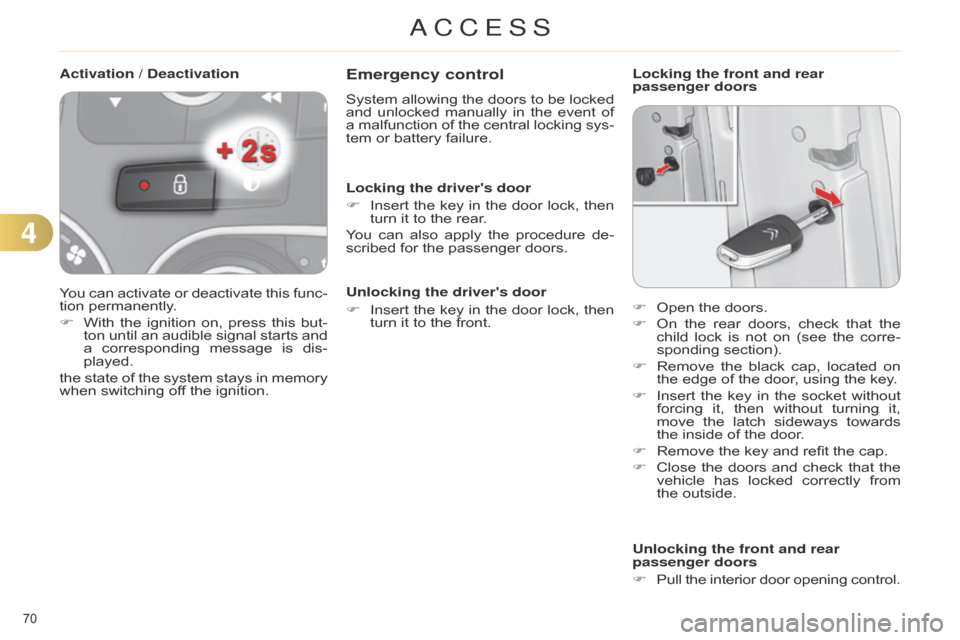
70
Emergency control
System allowing the doors to be locked and
unlocked manually in the event of
a
malfunction
of
the
central
locking
sys
-
tem
or battery failure.
Locking the driver's door
F
Insert
the
key
in
the
door
lock,
then
turn
it to the rear.
You
can
also
apply
the
procedure
de
-
scribed
for the passenger doors.
Unlocking the driver's door
F
Insert
the
key
in
the
door
lock,
then
turn
it to the front. Locking the front and rear
passenger doors
Unlocking the front and rear
passenger doors
F
Pull
the
interior
door
opening
control.
F
Open
the doors.
F
On
the
rear
doors,
check
that
the
child
lock
is
not
on
(see
the
corre
-
sponding
section).
F
Remove
the
black
cap,
located
on
the
edge of the door, using the key.
F
Insert
the
key
in
the
socket
without
forcing
it,
then
without
turning
it,
move
the
latch
sideways
towards
the
inside of the door.
F
Remove
the key and refit the cap.
F
Close
the
doors
and
check
that
the
vehicle
has
locked
correctly
from
the
outside.
Activation / Deactivation
You
can
activate
or
deactivate
this
func
-
tion
permanently.
F
With
the
ignition
on,
press
this
but
-
ton
until
an
audible
signal
starts
and
a
corresponding
message
is
dis
-
played.
the
state
of
the
system
stays
in
memory
when
switching
off
the
ignition.
4
ACCESS
Page 73 of 328
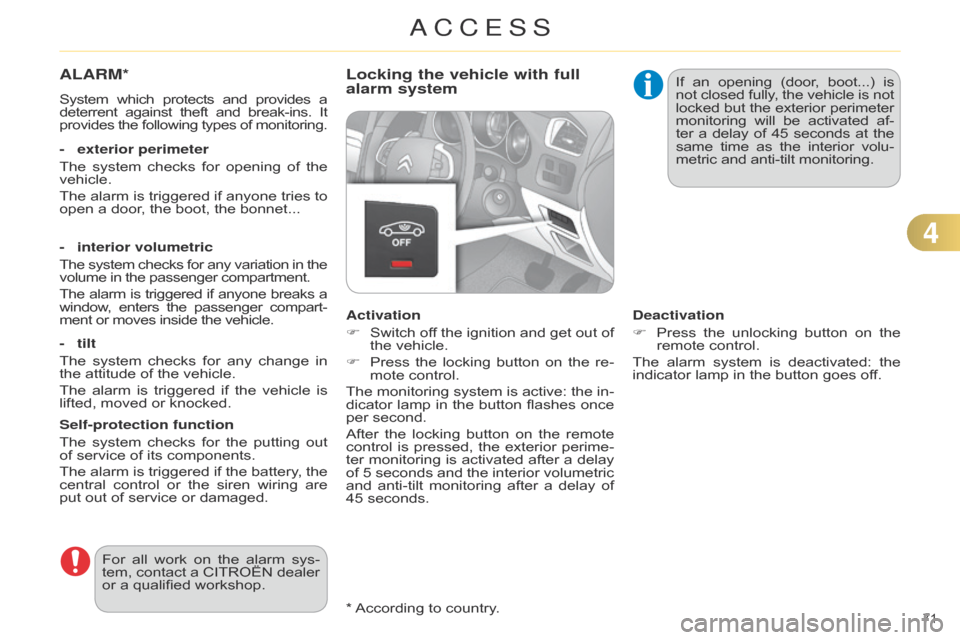
71 * According to country.
ALARM*
System which protects and provides a deterrent
against theft and break-ins. It provides
the
following
types
of
monitoring.
-
exterior perimeter
The
system
checks
for
opening
of
the
vehicle.
The
alarm
is
triggered
if
anyone
tries
to
open
a door, the boot, the bonnet...
-
interior volumetric
The
system
checks
for
any
variation
in
the volume
in the passenger compartment.
The
alarm
is
triggered
if
anyone
breaks
a window
,
enters
the
passenger
compart
-
ment
or moves inside the vehicle.
-
tilt
The
system
checks
for
any
change
in
the
attitude of the vehicle.
The
alarm
is
triggered
if
the
vehicle
is
lifted,
moved or knocked.
Self-protection function
The
system
checks
for
the
putting
out
of
service of its components.
The
alarm
is
triggered
if
the
battery
,
the
central
control
or
the
siren
wiring
are
put
out of service or damaged.
For
all
work
on
the
alarm
sys
-
tem,
contact
a
CITROËN
dealer
or
a qualified workshop.
Locking the vehicle with full
alarm system
Activation
F
Switch
of
f
the
ignition
and
get
out
of
the
vehicle.
F
Press
the
locking
button
on
the
re
-
mote
control.
The
monitoring
system
is
active:
the
in
-
dicator
lamp
in
the
button
flashes
once
per
second.
After
the
locking
button
on
the
remote
control
is
pressed,
the
exterior
perime
-
ter
monitoring
is
activated
after
a
delay
of
5
seconds
and
the
interior
volumetric
and
anti-tilt
monitoring
after
a
delay
of
45
seconds. If
an
opening
(door
,
boot...)
is not
closed
fully
,
the
vehicle
is
not locked
but
the
exterior
perimeter monitoring
will
be
activated
af
-
ter
a
delay
of
45
seconds
at
the same
time
as
the
interior
volu
-
metric and anti-tilt monitoring.
Deactivation
F
Press
the
unlocking
button
on
the
remote
control.
The
alarm
system
is
deactivated:
the
indicator
lamp in the button goes off.
4
ACCESS
Page 74 of 328
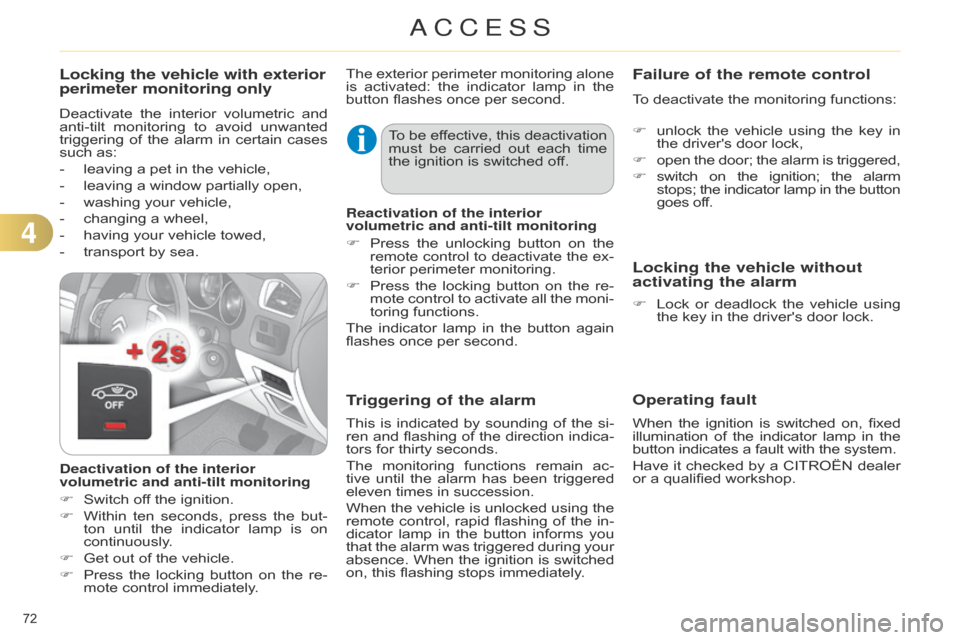
72
Operating fault
When the ignition is switched on, fixed illumination
of the indicator lamp in the button
indicates a fault with the system.
Have
it
checked
by
a
CITROËN
dealer
or
a qualified workshop.
Locking the vehicle with exterior
perimeter monitoring only
Deactivate the interior volumetric and anti-tilt
monitoring to avoid unwanted
triggering
of
the
alarm
in
certain
cases
such
as:
-
leaving
a pet in the vehicle,
-
leaving
a window partially open,
-
washing
your vehicle,
-
changing
a wheel,
-
having
your vehicle towed,
-
transport
by sea.
Deactivation of the interior
volumetric and anti-tilt monitoring
F
Switch
off the ignition.
F
Within
ten
seconds,
press
the
but
-
ton
until
the
indicator
lamp
is
on
continuously
.
F
Get
out of the vehicle.
F
Press
the
locking
button
on
the
re
-
mote
control immediately. The
exterior
perimeter
monitoring
alone
is
activated:
the
indicator
lamp
in
the
button
flashes once per second.
To
be
ef
fective,
this
deactivation
must
be
carried
out
each
time
the
ignition is switched off.
Reactivation of the interior
volumetric and anti-tilt monitoring
F
Press
the
unlocking
button
on
the
remote
control
to
deactivate
the
ex
-
terior
perimeter monitoring.
F
Press
the
locking
button
on
the
re
-
mote
control
to
activate
all
the
moni
-
toring
functions.
The
indicator
lamp
in
the
button
again
flashes
once per second.
Triggering of the alarm
This is indicated by sounding of the si -
ren and flashing of the direction indica -
tors
for thirty seconds.
The
monitoring
functions
remain
ac
-
tive
until
the
alarm
has
been
triggered
eleven
times in succession.
When
the
vehicle
is
unlocked
using
the
remote
control,
rapid
flashing
of
the
in
-
dicator
lamp
in
the
button
informs
you
that
the
alarm
was
triggered
during
your
absence.
When
the
ignition
is
switched
on,
this flashing stops immediately.
Failure of the remote control
To deactivate the monitoring functions:
F
unlock
the
vehicle
using
the
key
in
the
driver's door lock,
F
open
the
door;
the
alarm
is
triggered,
F
switch
on
the
ignition;
the
alarm stops;
the
indicator
lamp
in
the
button goes
off.
Locking the vehicle without
activating the alarm
F Lock or deadlock the vehicle using the
key in the driver's door lock.
4
ACCESS
Page 75 of 328
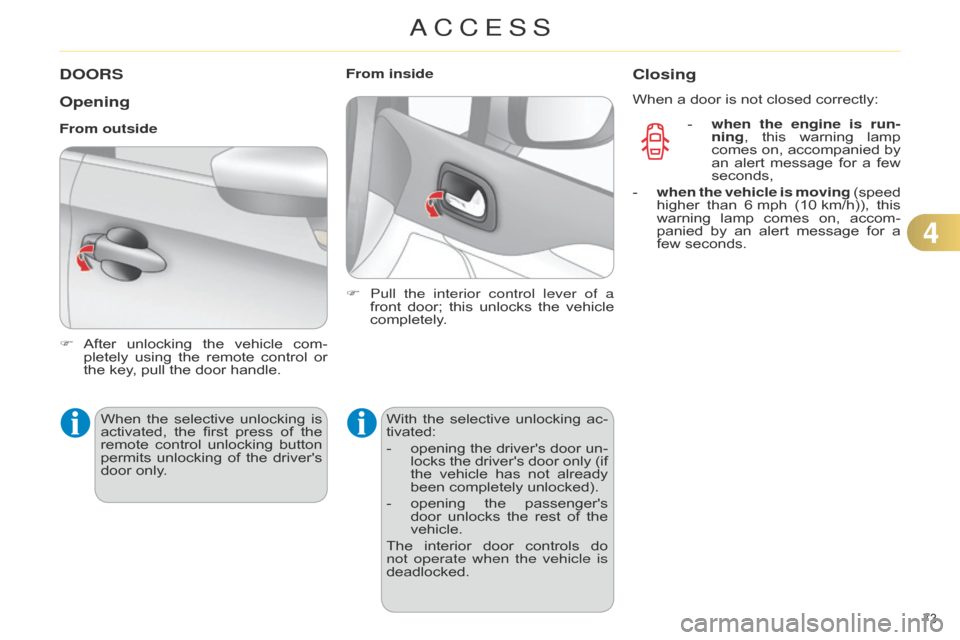
73
DOORS
Opening
F After unlocking the vehicle com -
pletely using the remote control or
the
key, pull the door handle.
From outside
When
the
selective
unlocking
is
activated,
the
first
press
of
the
remote
control
unlocking
button
permits
unlocking
of
the
driver's
door
only. F
Pull the
interior control lever of a
front
door;
this
unlocks
the
vehicle
completely
.
From inside
With
the
selective
unlocking
ac
-
tivated:
-
opening
the
driver's
door
un
-
locks
the
driver's
door
only
(if
the
vehicle
has
not
already
been
completely unlocked).
-
opening
the
passenger's
door
unlocks
the
rest
of
the
vehicle.
The
interior
door
controls
do
not operate when the vehicle is
deadlocked.
Closing
When a door is not closed correctly:
-
when the engine is run
-
ning,
this
warning
lamp
comes
on,
accompanied
by
an
alert
message
for
a
few
seconds,
-
when the vehicle is moving
(speed
higher
than
6
mph
(10
km/h)),
this
warning
lamp
comes
on,
accom
-
panied
by
an
alert
message
for
a
few
seconds.
4
ACCESS
Page 76 of 328
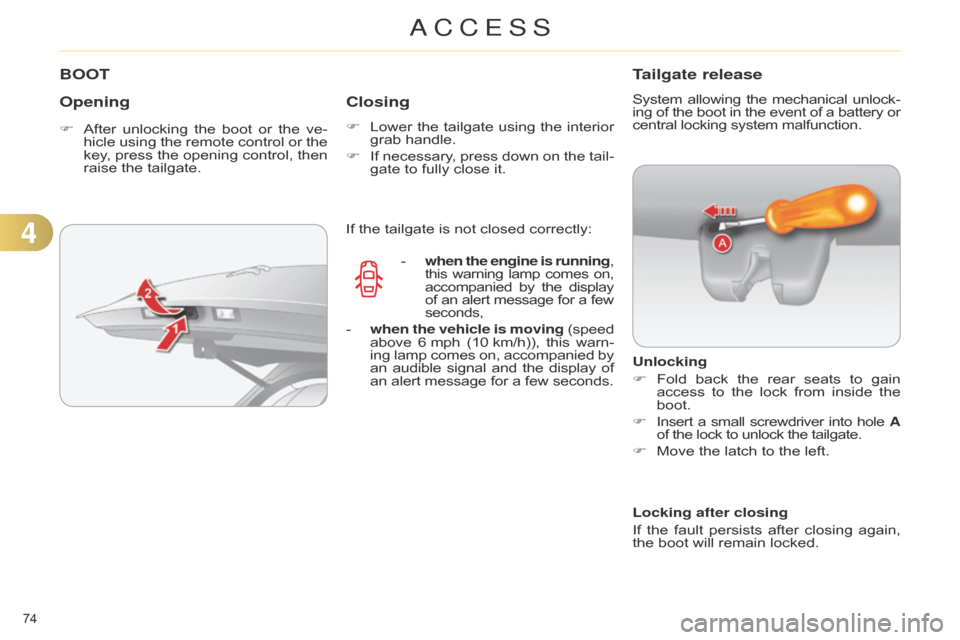
74
BOOT
Opening
F After unlocking the boot or the ve -
hicle using the remote control or the
key
,
press
the
opening
control,
then
raise
the tailgate.
Closing
F Lower the tailgate using the interior grab
handle.
F
If
necessary
,
press
down
on
the
tail
-
gate
to fully close it.
Tailgate release
System allowing the mechanical unlock -
ing of the boot in the event of a battery or central
locking system malfunction.
Unlocking
F
Fold
back
the
rear
seats
to
gain
access
to
the
lock
from
inside
the
boot.
F
Insert
a
small
screwdriver
into
hole
A
of
the lock to unlock the tailgate.
F
Move
the latch to the left.
If
the
tailgate
is
not
closed
correctly:
-
when
the engine is running,
this
warning
lamp
comes
on, accompanied
by
the
display of
an
alert
message
for
a
few seconds,
-
when the vehicle is moving
(speed above
6
mph
(10
km/h)),
this
warn
-
ing
lamp
comes
on,
accompanied
by an
audible
signal
and
the
display
of an
alert
message
for
a
few
seconds. Locking after closing
If
the
fault
persists
after
closing
again,
the
boot will remain locked.
4
ACCESS
Page 77 of 328
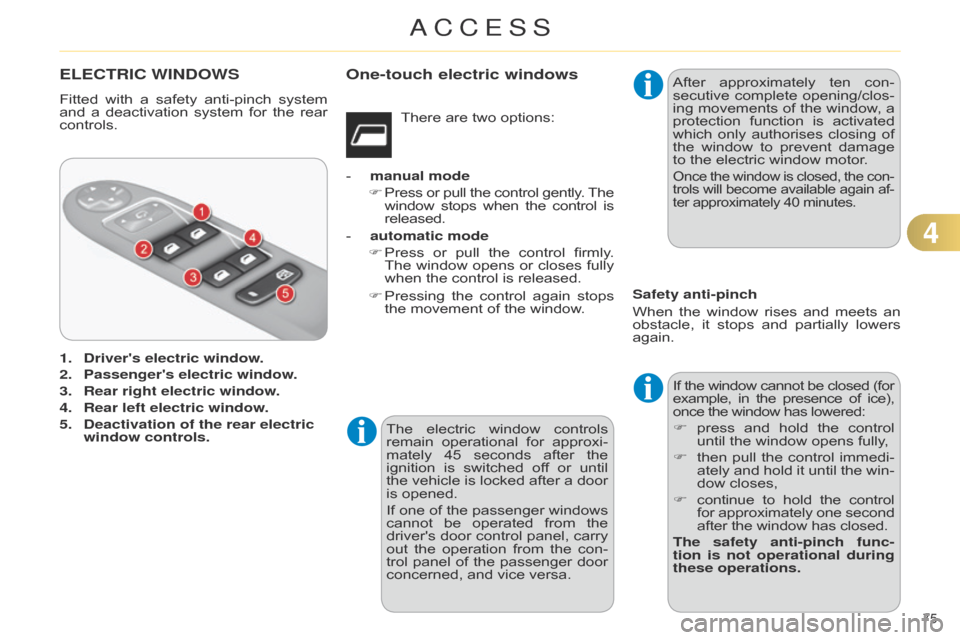
75
ELECTRIC WINDOWS
Fitted with a safety anti-pinch system and
a deactivation system for the rear
controls.
1.
Driver's electric window
.
2.
Passenger's electric window
.
3.
Rear right electric window
.
4.
Rear left electric window
.
5.
Deactivation of the rear electric
window controls. The
electric
window
controls
remain
operational
for
approxi
-
mately
45
seconds
after
the
i
gnition
is
switched
of
f
or
until
the
vehicle
is
locked
after
a
door
is
opened.
If
one
of
the
passenger
windows
cannot
be
operated
from
the
driver's
door
control
panel,
carry
out
the
operation
from
the
con
-
trol
panel
of
the
passenger
door
concerned,
and vice versa.After
approximately
ten
con
-
secutive complete opening/clos -
ing movements of the window , a
protection
function
is
activated
which
only
authorises
closing
of
the
window
to
prevent
damage
to
the electric window motor.
Once the window is closed, the con -
trols will become available again af -
ter
approximately 40 minutes.
If the window cannot be closed (for example,
in the presence of ice), once
the window has lowered:
F
press
and
hold
the
control
until
the window opens fully,
F
then
pull
the
control
immedi
-
ately
and
hold
it
until
the
win
-
dow
closes,
F
continue
to
hold
the
control for
approximately
one
second after
the window has closed.
The safety anti-pinch func-
tion is not operational during
these operations.
There
are
two
options:
-
manual mode
F
Press
or
pull
the
control
gently
.
The window
stops
when
the
control
is released.
-
automatic mode
F
Press
or
pull
the
control
firmly
.
The
window
opens
or
closes
fully
when
the
control
is
released.
F
Pressing
the
control
again
stops
the
movement
of
the
window.
Safety anti-pinch
When
the
window
rises
and
meets
an
obstacle,
it
stops
and
partially
lowers
again.
One-touch electric windows
4
ACCESS
Page 78 of 328
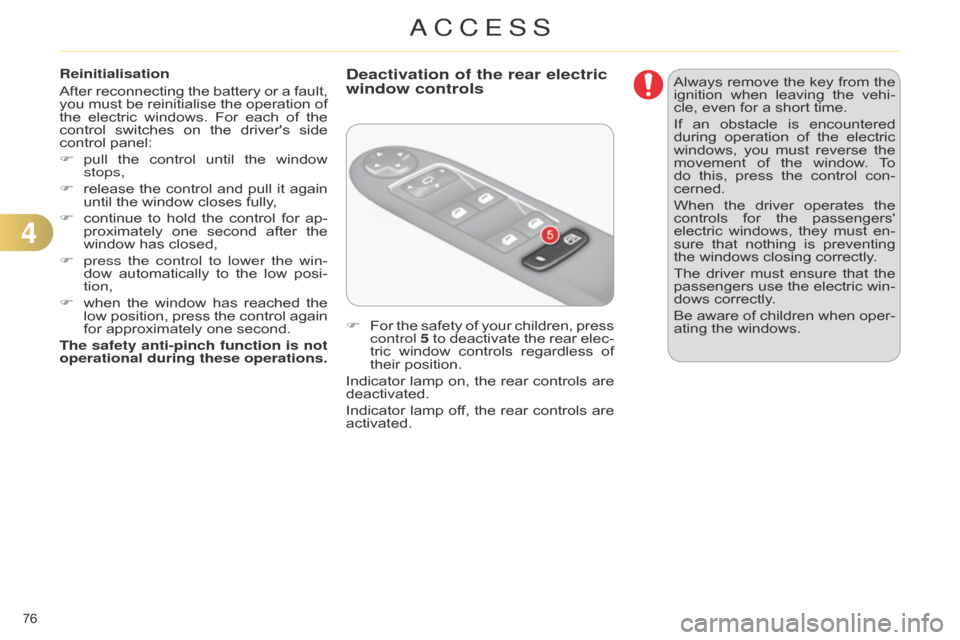
76
Reinitialisation
After
reconnecting
the
battery
or
a
fault,
you
must
be
reinitialise
the
operation
of
the
electric
windows.
For
each
of
the
control
switches
on
the
driver's
side
control
panel:
F
pull
the
control
until
the
window
stops,
F
release
the
control
and
pull
it
again
until
the window closes fully,
F
continue
to
hold
the
control
for
ap
-
proximately
one
second
after
the
window
has closed,
F
press the control to lower the win
-
dow
automatically
to
the
low
posi
-
tion,
F
when
the
window
has
reached
the
low
position,
press
the
control
again
for
approximately one second.
The safety anti-pinch function is not
operational during these operations. F
For
the
safety
of
your
children,
press
control 5
to
deactivate
the
rear
elec
-
tric
window
controls
regardless
of
their
position.
Indicator
lamp
on,
the
rear
controls
are
deactivated.
Indicator
lamp
of
f,
the
rear
controls
are
activated.
Deactivation of the rear electric
window controlsAlways remove the key from the ignition
when leaving the vehi -
cle,
even for a short time.
If
an
obstacle
is
encountered
during
operation
of
the
electric
windows,
you
must
reverse
the
movement
of
the
window
.
T
o
do
this,
press
the
control
con
-
cerned.
When
the
driver
operates
the
controls
for
the
passengers'
electric
windows,
they
must
en
-
sure
that
nothing
is
preventing
the
windows closing correctly.
The
driver
must
ensure
that
the
passengers
use
the
electric
win
-
dows
correctly.
Be
aware
of
children
when
oper
-
ating
the windows.
4
ACCESS
Page 79 of 328
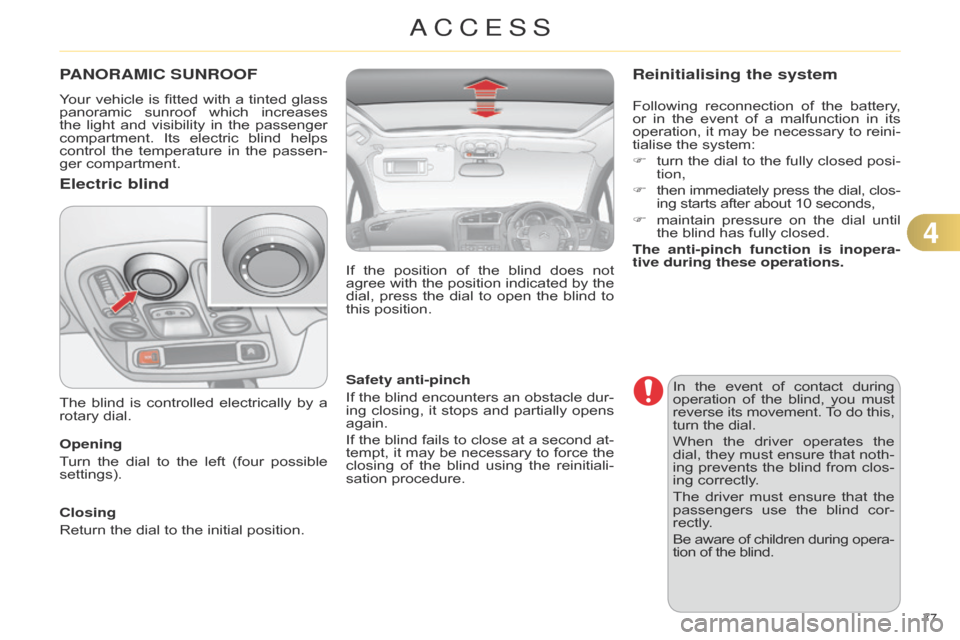
77
PANORAMIC SUNROOF
Your vehicle is fitted with a tinted glass panoramic
sunroof which increases
the
light
and
visibility
in
the
passenger
compartment.
Its
electric
blind
helps
control
the
temperature
in
the
passen
-
ger
compartment.
Electric blind
Opening
Turn
the
dial
to
the
left
(four
possible
settings).
Closing
Return
the dial to the initial position.Safety anti-pinch
If
the
blind
encounters
an
obstacle
dur
-
ing
closing,
it
stops
and
partially
opens
again.
If
the blind fails to close at a second at -
tempt, it may be necessary to force the
closing
of
the
blind
using
the
reinitiali
-
sation
procedure.
The
blind
is
controlled
electrically
by
a
rotary
dial. In
the
event
of
contact
during operation
of
the
blind,
you
must reverse
its
movement.
T
o
do
this, turn
the dial.
When the driver operates the dial,
they must ensure that noth -
ing
prevents
the
blind
from
clos
-
ing
correctly.
The
driver
must
ensure
that
the
passengers
use
the
blin
d
cor
-
rectly.
Be
aware
of
children
during
opera
-
tion
of the blind.
Reinitialising the system
Following reconnection of the battery , or
in the event of a malfunction in its
operation,
it
may
be
necessary
to
reini
-
tialise
the system:
F
turn
the
dial
to
the
fully
closed
posi
-
tion,
F
then
immediately
press
the
dial,
clos
-
ing
starts after about 10 seconds,
F
maintain
pressure
on
the
dial
until
the
blind has fully closed.
The anti-pinch function is inopera-
tive during these operations.
If
the
position
of
the
blind
does
not
agree
with
the
position
indicated
by
the
dial,
press
the
dial
to
open
the
blind
to
this
position.
4
ACCESS
Page 80 of 328
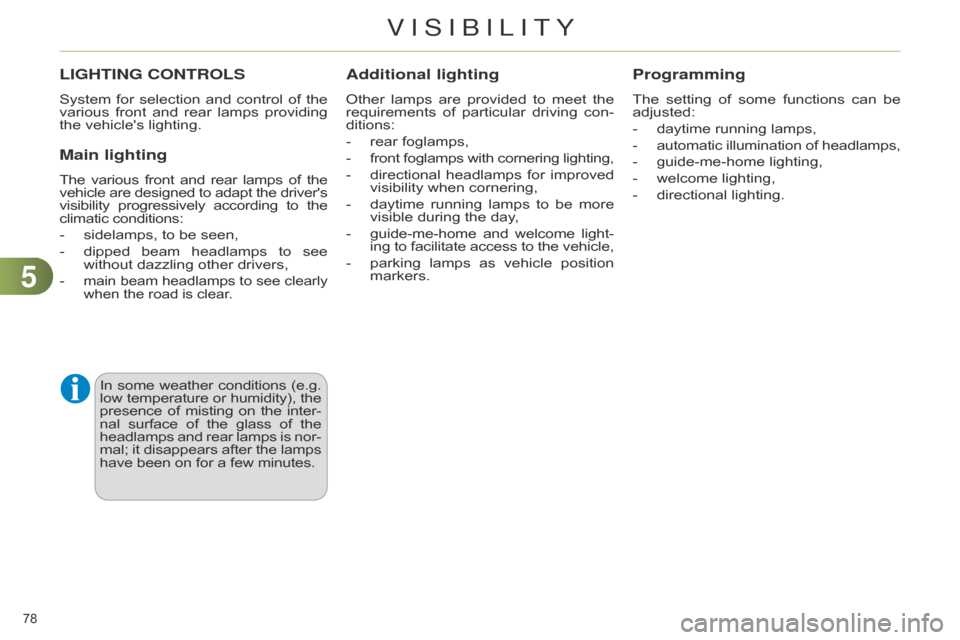
55
78
LIGHTING CONTROLS
System for selection and control of the various
front and rear lamps providing
the
vehicle's lighting.
Main lighting
The various front and rear lamps of the vehicle
are designed to adapt the driver's visibility
progressively
according
to
the climatic
conditions:
-
sidelamps,
to be seen,
-
dipped
beam
headlamps
to
see
without
dazzling other drivers,
-
main beam headlamps to see clearly when
the road is clear.
Additional lighting
Other lamps are provided to meet the requirements
of particular driving con -
ditions:
-
rear
foglamps,
-
front
foglamps
with
cornering
lighting,
-
directional
headlamps
for
improved
visibility
when cornering,
-
daytime
running
lamps
to
be
more
visible
during the day,
-
guide-me-home
and
welcome
light
-
ing
to
facilitate
access
to
the
vehicle,
-
parking
lamps
as
vehicle
position
markers.
Programming
The setting of some functions can be adjusted:
-
daytime
running lamps,
-
automatic
illumination
of
headlamps,
-
guide-me-home
lighting,
-
welcome
lighting,
-
directional
lighting.
In
some
weather
conditions
(e.g. low
temperature
or
humidity),
the presence
of
misting
on
the
inter
-
nal
surface
of
the
glass
of
the headlamps
and
rear
lamps
is
nor
-
mal;
it
disappears
after
the
lamps have
been
on
for
a
few
minutes.
VISIBILITY